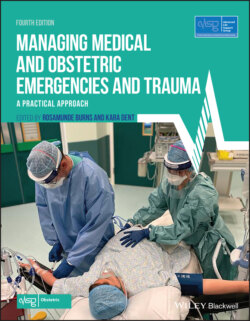Читать книгу Managing Medical and Obstetric Emergencies and Trauma - Группа авторов - Страница 99
6.2 Aortocaval compression and supine hypotension syndrome
ОглавлениеIn the pregnant woman in a supine position, the uterus compresses the vena cava, reducing venous return to the heart from 20 weeks’ gestation. Vena caval obstruction and aortic compression can reduce cardiac output by up to 30%. The woman may experience symptoms such as nausea, vomiting or lightheadedness. This is known as supine hypotension syndrome. The reduction in venous return impacts on placental blood flow, which lacks autoregulation.
To prevent the effects of aortocaval compression, the pregnant woman should lie in the lateral position. Although a 15° tilt to the left (Figure 6.1b) is advocated there is evidence that the effects of compression still occur. Manual displacement of the uterus off the inferior vena cava up and to the left, relieves compression more effectively (Figure 6.1a). It is important to remember to relieve aortocaval compression in the initial management of the shocked woman to not exacerbate hypotension from other causes.
Figure 6.1 (a) Manual uterine displacement in the pregnant woman. (b) Fifteen degrees of left lateral tilt
Source: (a) Courtesy of Trauma Victoria – Obstetric Trauma guideline. http://trauma.reach.vic.gov.au/
To prompt manual uterine displacement (MUD) early in the process of resuscitation, remember:
‘Hello. How are you Ms MUD?’
